Related Research Articles

The gens Julia was one of the most prominent patrician families in ancient Rome. Members of the gens attained the highest dignities of the state in the earliest times of the Republic. The first of the family to obtain the consulship was Gaius Julius Iulus in 489 BC. The gens is perhaps best known, however, for Gaius Julius Caesar, the dictator and grand uncle of the emperor Augustus, through whom the name was passed to the so-called Julio-Claudian dynasty of the first century AD. The nomen Julius became very common in imperial times, as the descendants of persons enrolled as citizens under the early emperors began to make their mark in history.
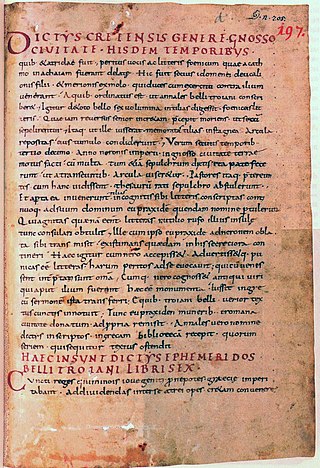
Dictys Cretensis, i.e. Dictys of Crete of Knossos was a legendary companion of Idomeneus during the Trojan War, and the purported author of a diary of its events, that deployed some of the same materials worked up by Homer for the Iliad. The story of his journal, an amusing fiction addressed to a knowledgeable Alexandrian audience, came to be taken literally during Late Antiquity.
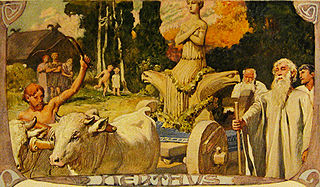
In Germanic paganism, Nerthus is a goddess associated with a ceremonial wagon procession. Nerthus is attested by first century AD Roman historian Tacitus in his ethnographic work Germania.

The Germania, written by the Roman historian Publius Cornelius Tacitus around 98 AD and originally entitled On the Origin and Situation of the Germans, is a historical and ethnographic work on the Germanic peoples outside the Roman Empire.

Gian Francesco Poggio Bracciolini, usually referred to simply as Poggio Bracciolini, was an Italian scholar and an early Renaissance humanist. He was responsible for rediscovering and recovering many classical Latin manuscripts, mostly decaying and forgotten in German, Swiss, and French monastic libraries. His most celebrated finds are De rerum natura, the only surviving work by Lucretius, De architectura by Vitruvius, lost orations by Cicero such as Pro Sexto Roscio, Quintilian's Institutio Oratoria, Statius' Silvae, and Silius Italicus's Punica, as well as works by several minor authors such as Frontinus' De aquaeductu, Ammianus Marcellinus' Res Gestae, Nonius Marcellus, Probus, Flavius Caper, and Eutyches.
Publius Pomponius Secundus was a distinguished statesman and poet in the reigns of Tiberius, Caligula, and Claudius. He was suffect consul for the nundinium of January to June 44, succeeding the ordinary consul Gaius Sallustius Crispus Passienus and as the colleague of the other ordinary consul, Titus Statilius Taurus. Publius was on intimate terms with the elder Pliny, who wrote a biography of him, now lost.
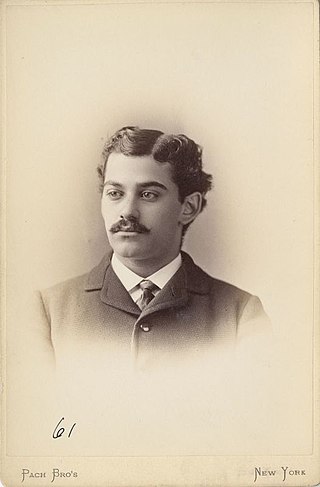
Alfred Gudeman was an American-German classical scholar.
The Agricola is a book by the Roman writer, Tacitus, written c. AD 98. The work recounts the life of his father-in-law Gnaeus Julius Agricola, an eminent Roman general and Governor of Britain from AD 77/78 – 83/84. It also covers the geography and ethnography of ancient Britain.

The Dialogus de oratoribus is a short work attributed to Tacitus, in dialogue form, on the art of rhetoric. Its date of composition is unknown, though its dedication to Lucius Fabius Justus places its publication around 102 AD.
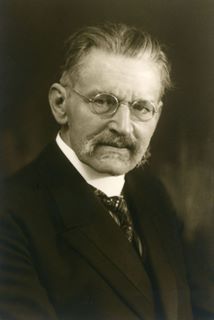
Richard August Reitzenstein was a German classical philologist and scholar of Ancient Greek religion, hermetism and Gnosticism. He is described by Kurt Rudolph as “one of the most stimulating Gnostic scholars.” With Wilhelm Bousset, he was one of the major figures of the Religionsgeschichtliche Schule.

Publius Cornelius Tacitus, known simply as Tacitus, was a Roman historian and politician. Tacitus is widely regarded as one of the greatest Roman historians by modern scholars.
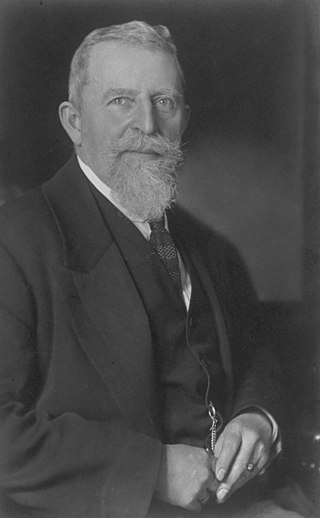
Rudolf Much was an Austrian philologist and historian who specialized in Germanic studies. Much was Professor and Chair of Germanic Linguistic History and Germanic Antiquity at the University of Vienna, during which he tutored generations of students and published a number of influential works, some of which have remained standard works up to the present day.
Carl Schmidt was a German Coptologist. He made editions of various Coptic texts, and was active in Egypt in purchasing papyri for German universities. He also assisted Sir Chester Beatty in his papyri purchases.
Justus Friedrich Kritz was a German schoolteacher and classical philologist, known for his scholarly examination of the Roman historian Sallust.
Marcus Cornelius Nigrinus Curiatius Maternus was a Roman senator and general during the reign of Domitian. He was suffect consul during the nundinium of September to October AD 83 with Lucius Calventius Sextius Carminius Vetus. Although some experts consider him a rival with Trajan as heir apparent to the emperor Nerva, he is primarily known from inscriptions.
Lucius Fabius Justus was a Roman senator who occupied a number of offices in the imperial service. He also served as suffect consul in 102, replacing Lucius Licinius Sura as the colleague of the consul who opened the year, Lucius Julius Ursus Servianus; both Justus and Servianus closed their nundinium at the end of April.

Branchwork or branch tracery is a type of architectural ornament often used in late Gothic architecture and the Northern Renaissance, consisting of knobbly, intertwined and leafless branches. Branchwork was particularly widespread in Central European art between 1480 and 1520 and can be found in all media. The intellectual origin of branchwork lies in theories in Renaissance humanism about the origins of architecture in natural forms and barely-treated natural materials.

Eugen Fehrle was a German philologist who specialized in classical and Germanic philology.
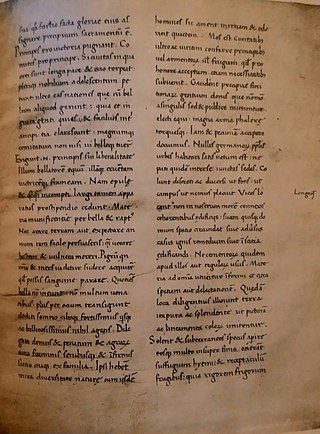
The Codex Aesinas is a 15th-century composite manuscript. It was discovered by chance in 1902 at the former private estate of the Count Baldeschi Balleani family located in Jesi, in the province of Ancona, Italy. The manuscript is considered especially valuable because it contains the Opera Minora of the Roman historian Tacitus, including the Agricola and the Germania. Due to the inclusion of eight folia written in Carolingian minuscule script within the Agricola, the Tacitus portion of the Codex is generally regarded as a direct copy of the missing Codex Hersfeldensis (H), a 9th-century manuscript that contained a copy of the original Opera Minora by Tacitus. The Carolingian folia are thought to be originals taken from the lost codex. In 1994, the Baldeschi Balleani family sold the codex to the Biblioteca Nazionale Centrale di Roma where it is now known as the Codex Vittorio Emanuele 1631.
The gens Urbinia was an obscure plebeian family at ancient Rome. Only a few members of this gens are mentioned by Roman writers, but others are known from inscriptions.
References
- Ludwig Pralle: Die Wiederentdeckung des Tacitus. Verlag Parzeller, Fulda 1952
- Bernhard Bischoff: Das benediktinische Mönchtum und die Überlieferung der klassischen Literatur. In: Studien und Mitteilungen zur Geschichte des Benediktiner-Ordens 92 (1981), S. 165–190, hier S. 181.
- Michael Fleck: Der Codex Hersfeldensis des Tacitus: eine abenteuerliche Geschichte aus der Zeit der Renaissance. In: Hersfelder Geschichtsblätter. Band 1 (2006), S. 98–113.
- Heinz Heubner: Die Überlieferung der Germania des Tacitus. In: Herbert Jankuhn, Dieter Timpe (Hrsg.): Beiträge zum Verständnis der Germania des Tacitus. Bericht über die Kolloquien der Kommission für die Altertumskunde Nord- und Mitteleuropas im Jahr 1986. Teil 1. Vandenhoeck & Ruprecht, Göttingen 1989, ISBN 3-525-82459-9, S. 16–26.
- Harald Merklin: ′Dialogus′-Probleme in der neueren Forschung. In: Wolfgang Haase et al. (Hrsg.): Aufstieg und Niedergang der römischen Welt II. Prinzipat, Band 33,3. Walter de Gruyter, Berlin/New York 1991. ISBN 3-11-012541-2, S. 2255–2283.
- Dieter Mertens: Die Instrumentalisierung der „Germania“ des Tacitus durch die deutschen Humanisten. In: Heinrich Beck (Hrsg.): Zur Geschichte der Gleichung „germanisch–deutsch“: Sprache und Namen, Geschichte und Institutionen. Walter de Gruyter, Berlin/New York 2004, ISBN 978-3-11-017536-3, S. 37–101 ( Ergänzungsbände zum Reallexikon der Germanischen Altertumskunde , 34; online als PDF).
- Charles E. Murgia: Review Article: The Minor Works of Tacitus. A Study in Textual Criticism Cornelii Taciti Opera minora by M. Winterbottom, R. M. Ogilvie. In: Classical Philology 72, 4 (1977), S. 323–343.
- Charles E. Murgia, R. H. Rodgers: A Tale of Two Manuscripts. In: Classical Philology 79, 2 (1984), S. 145–153.
- Rodney P. Robinson: The Inventory of Niccolo Niccoli. In: Classical Philology 16, 3 (1921), S. 251–255. (online)
- Franz Römer: Kritischer Problem- und Forschungsbericht zur Überlieferung der taciteischen Schriften. In: Wolfgang Haase et al. (Hrsg.): Aufstieg und Niedergang der römischen Welt II. Prinzipat, Band 33,3. de Gruyter, Berlin/New York 1991, ISBN 3-11-012541-2, S. 2299–2339.
- Rudolf Till: Handschriftliche Untersuchungen zu Tacitus Agricola und Germania, mit einer Photokopie des Codex Aesinas. Berlin-Dahlem 1943.
- Michael Winterbottom: The Manuscript Tradition of Tacitus' Germania. In: Classical Philology 70, 1 (1975), S. 1–7.